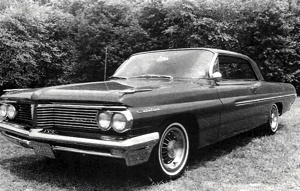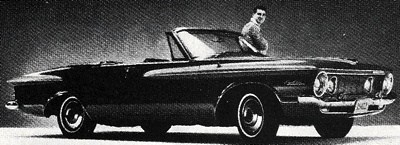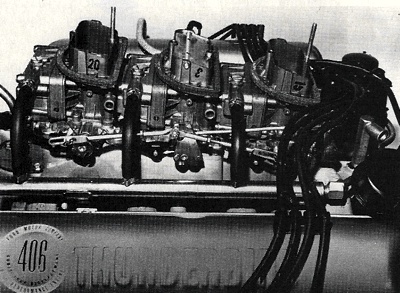|
American Muscle Cars of 1962
|
Country: |
 |
 The Catalina with a Trophy 425-A engine was one of the fastest
for 1962.
The Catalina with a Trophy 425-A engine was one of the fastest
for 1962. |
Some automotive historians say the musclecar era started in
1964, with the introduction of the GTO. But that simply wasn't the case. The GTO was a definite letdown from some of the factory-built iron that was running around in the early 1960s, yet from a marketing standpoint, the "Goat" was a perfectly packaged
automobile for the enthusiast crowd.
But the marketing types were still grappling with the various aspects of high performance in
1962. They knew that a car like a 409 Chevy could build showroom traffic, but it was the 327s and 283s that they wanted to roll down the highway in great numbers. Muscle machines like the 409s were big warranty headaches for the corporate and dealer execs.
But in
1962, the offerings on the hi-po option sheets represented a quantum leap forward from just the year before. Once Detroit got on the Super Stock kick with the early Ford Specials and the 409 Chevy, developments came almost as fast as they could chum them out. The superpowers of Detroit, meanwhile, were locked in a combat of their own on the streets and strips. It seemed the horsepower race, like the arms race, was escalating every day, with no end in sight.
There was nothing more exciting for enthusiasts than to head down to the local drag strip on Sunday morning and see that new muscle car they 'had been reading about in the car magazines lined up in the staging lanes. And it seemed as though every week there was a different one. Let's run down the five or six
1962 models that were making the news, and winning the stoplight bashes, on the American streets and drag strips that year.
Chevrolet 409
The famous 409 Chevy was introduced in the spring of 1961, but due to manufacturing problems and lack of engineering manpower, only some 142 409s were actually built and sold in the 1961 model year. In no sense could it be said to be a "popular" street model that year. It was launched on the Chevrolet reputation alone, and "Dyno" Don Nicholson made it famous before theBeachBoys. Many Chevy aficionados were worshipping the 409 model before they ever even saw one. But
1962 was another story. The '62 models were ready in October of '61, and previous production problems had been solved. You could order a 409 at any Chevy dealership and expect delivery within four weeks. Several thousand 409s were built in the eight months that followed.
You could get the package on any full-size Chevy, including station wagons, and with 3-or 4-speed manual transmissions, both with factory floor shifter. Automatic transmission and
air-conditioning were not available options because of the 6500 rpm capability of the solid lifters. Chevy hadn't yet "civilised" the 409. The big changes that year were aimed at better breathing. These included a new dual 4-barrel carburettor system, using two 650 cfm Carter AFBs on a new aluminium 2-plane manifold, and new
cylinder head castings with V4-inch higher intake ports and intake valve diameter increased from 2.07 to 2.20 inches. New forged pistons had high-turbulence domes, but Chevy still fitted two head gaskets at the factory, which dropped compression ratio one full point, to allow for pump gas under 100 octane.
Racers pulled 11.25:1 compression with single gaskets. It's interesting that Chevy offered a Service Package for NASCAR racers, which included a special Carter 4-barrel carb and unheated manifold, hotter cam, stiffer valve springs, heavy duty pushrods and special streamlined cast-iron
exhaust manifolds. NASCAR rules required all factory parts in those days, right down to the
exhaust system. The new 8-barrel 409 for '62 was rated at 409 gross hp at 6000 rpm. And the improved breathing was good for consistent quarter mile times in the high 14-second range at 95 to 98 mph and a top speed of 135 mph with the right gearing. But a 409 set up specifically for the drags could run much stronger. Dave Strickler and Bill Jenkins ran the "Old Reliable II," one of the most famous Chevy drag cars of all time. And it ran consistent low 12s at around 115 mph in the quarter. Other notable 409s included those driven by Hayden Profitt, Frank Sanders, Butch Leal and Dyno Don.

The Super Fury was Plymouth's flagship for 1962.
 Ford's new 406 V8 boasted an increased exhaust valve diameter, upping net output by around 10 bhp.
Ford's new 406 V8 boasted an increased exhaust valve diameter, upping net output by around 10 bhp.
|
Dodge/Plymouth Max Wedge
The Chrysler people may have been last with their Super Stock-type cars in the early '60s, but they certainly weren't least. We're speaking, of course, of the famous Max Wedge models introduced in the '62 model year. These were unquestionably the closest things to all-out racing cars ever released for licensed street use in Detroit history. The
engine was based on the 413-cubic-inch big-block, with dual-quad crossram manifold, special big-port heads, forged pistons, 300-degree solid cam with 300-pound valve springs, beefed bottom end and fantastic split-flow cast-iron
exhaust headers that looped up over the fender wells and dumped to 3-inch outlets. Under the car was a 3-inch dual pipe/muffler system, with headpipe outlets that could be uncapped in five minutes for all-out street or strip racing. All this was combined with heavy duty suspension and
brakes and a rear axle pinion snubber for windup control.
The goodies were scrambled into the little Mopar B-body coupes that weighed only 3300 pounds, ready to go. And there was more. You had your choice of a street or strip version of the whole package. For the street, you got 11:1 compression, 3.91 axle gears with Sure Grip and your choice of a heavy duty 3-speed manual or a special, beefed up version of the 3-speed TorqueFlite automatic. In fact, the latter was the best for off-the-line jump with the skinny, low-traction tires of the day. And no one could shift quicker than an automatic.
Automatics had always been the last thing you'd want in a performance car. Yet overnight the TorqueFlites were making believers out of many a diehard. It would be a lie to say these Dodge/ Plymouth Max Wedge cars of the early '60s made practical street machines. With rich carb jetting, 1200 rpm idle speed and the high-overlap cam, not to mention the neck-snapping shifts with the racing TorqueFlite, the cars were a positive headache to drive on the street. But if you wanted to win stoplight drags ... a
1962 Dodge Ramcharger was capable of 13.36 at 109.86 mph.
Ford upgraded its big-block SS
engine in
1961 by increasing cubes to 390 and going to an impressive 6-barrel carburettor system late in the model year. For 1962, the same triple carburettor system was retained, with more venturi area and an improved progressive throttle linkage, and a slight increase in bore raised cubes to 406. The advertised power rating was increased only from 401 to 405 hp at 6000 rpm, but an increase in
exhaust valve diameter seemed to increase net output by about 10 hp. It should also be mentioned that the cylinder block casting and connecting rods were beefed, mostly for NASCAR track racing. The
1962 406 Fords were probably the weakest of the Detroit Super Stocks that year. Not only was
engine power on the soft side, but the popular Galaxie coupes on a 119-inch wheelbase that year weighed 4200 pounds. It gave 0-to-60 mph times of 7.0 seconds and quarter mile ET of 15.3 at 90 mph. The Fords had a tough time in the pro ranks of drag racing as well, up against the Mopars and Chevys of the day. But greats like Gas Rhonda, Ed Martin and Les Ritchey carried the Ford banner to many victories.
Positraction & Hurst Floor Shifter
Pontiac's famous 389-cubic-inch Trophy 425-A
engine mill Tri-Power carburetion (348 hp) was one of the hotter street engines for the entire 1960 to 1964 period — in almost any base car. It used a hydraulic cam and only revved to 5800 rpm, but it was a very healthy
engine from the word go. The
1962 model year was no exception. In fact, road tests showed the Trophy
engine in a
Catalina Coupe to be just about as quick as a Ford 406 6-barrel
engine in a Galaxie. The Trophy was an
engine that had to be dealt with on the street. Most musclecar fans are aware that Pontiac introduced its famous 421 competition
engine in early 1962. But few know you could get a single 4-barrel version in a street machine at the time. For some $400 extra, you could order it in a Catalina coupe or the then new Grand Prix sports coupe, with a complete heavy duty chassis, 3.42 gears with Positraction and your choice of 3-or 4-speed manual transmission with Hurst floor shifter.
There was precious little compromise in the
engine setup for the street, too. Like 11:1 compression instead of 13.5, 308-degree solid cam and a dual under-car
exhaust system fed from the big NASCAR split-flow castings that weighed 80 pounds together! Advertised rating was 405 gross hp at 5800 rpm, and the
engine would do it with open
exhaust. The
1962 Grand Prix with 4-speed and 3.42 axle gears could pull 0-to-60 mph in 6.0 seconds and quarter mile in 14.3 at 103 mph, with a curb weight of some 4000 pounds. This certainly had to be one of the best performance-per-dollar buys in the
1962 model crop. Pontiac built 224 cars that year with the 421 race
engine, and over 150 of them were these Catalina and GP street jobs. Rare cars today.



